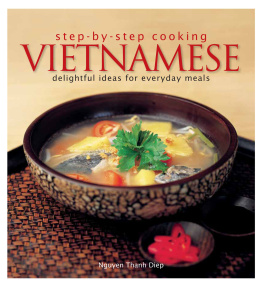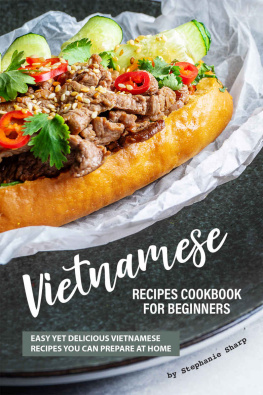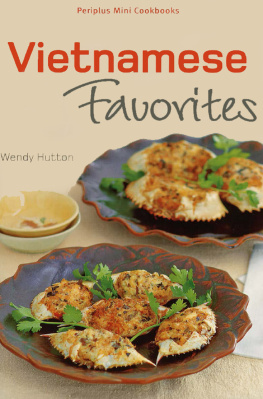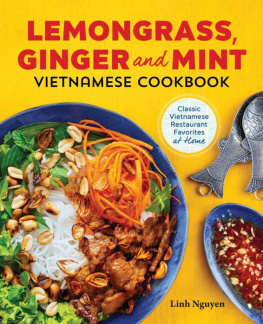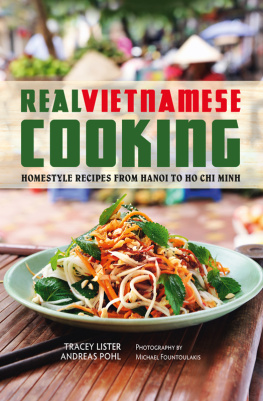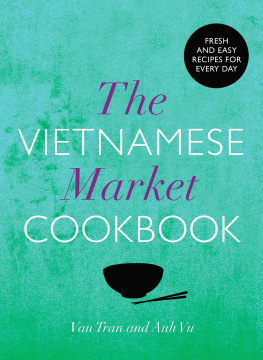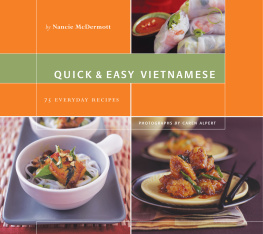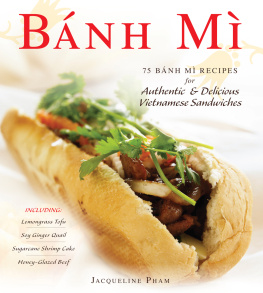The Publisher wishes to thank Barang Barang Pte Ltd and Lims Arts and Living for the loan and use of
their tableware.
Photographer: Sam Yeo
Food Preparation: Cheong Mee Siew
First published 2005 as Feast of Flavours from the Vietnamese Kitchen
This new edition 2009
2005 Marshall Cavendish International (Asia) Private Limited
Published by Marshall Cavendish Cuisine
An imprint of Marshall Cavendish International
1 New Industrial Road, Singapore 536196
All rights reserved
No part of this publication may be reproduced, stored in a retrieval system or transmitted, in any
form or by any means, electronic, mechanical, photocopying, recording or otherwise, without
the prior permission of the copyright owner. Request for permission should be addressed to the
Publisher, Marshall Cavendish International (Asia) Private Limited,
1 New Industrial Road, Singapore 536196. Tel: (65) 6213 9300, Fax: (65) 6285 4871
E-mail:
Online bookstore: http://www.marshallcavendish.com/genref
Limits of Liability/Disclaimer of Warranty: The Author and Publisher of this book have used their best
efforts in preparing this book. The Publisher makes no representation or warranties with respect to
the contents of this book and is not responsible for the outcome of any recipe in this book. While the
Publisher has reviewed each recipe carefully, the reader may not always achieve the results desired
due to variations in ingredients, cooking temperatures and individual cooking abilities. The Publisher
shall in no event be liable for any loss of profit or any other commercial damage, including but not
limited to special, incidental, consequential, or other damages.
Other Marshall Cavendish Offices:
Marshall Cavendish Ltd. 5th Floor, 32-38 Saffron Hill, London EC1N 8FH, UK Marshall Cavendish
Corporation. 99 White Plains Road, Tarrytown NY 10591-9001, USA Marshall Cavendish
International (Thailand) Co Ltd. 253 Asoke, 12th Flr, Sukhumvit 21 Road, Klongtoey Nua, Wattana,
Bangkok 10110, Thailand Marshall Cavendish (Malaysia) Sdn Bhd, Times Subang, Lot 46, Subang
Hi-Tech Industrial Park, Batu Tiga, 40000 Shah Alam, Selangor Darul Ehsan, Malaysia.
Marshall Cavendish is a trademark of Times Publishing Limited
National Library Board Singapore Cataloguing in Publication Data
Nguyen Thanh Diep.
Vietnamese : delightful ideas for everyday meals / Nguyen Thanh Diep. New ed. Singapore :
Marshall Cavendish Cuisine, 2009.
p. cm. (Step-by-step cooking series)
eISBN-13 : 978 981 4435 19 2
ISBN-10 : 981-261-797-3
1. Cookery, Vietnamese. I. Title. II. Series: Step-by-step cooking series (Marshall Cavendish Cuisine)
TX724.5.V5
641.59597 -- dc22 OCN320051634
Printed in Singapore by Times Printers Pte Ltd
CONTENTS
COOKING TECHNIQUES
Vietnamese cooking does not require knowledge of any special skill or complicated
technique. Often the key lies in getting the freshest possible ingredients because
many, especially vegetables, are eaten raw or lightly cooked. The reliance on
natural flavours is considerable in Vietnamese cuisine. At other times, strong
flavours are boldly brought together by a combination of the dish itself and the
accompanying dipping sauce. Although on the side, the dipping sauce, like the raw
salad, contributes greatly to the overall taste, texture and enjoyment of the dish.
Consequently, much attention should be paid to the preparation of not only the
main dish, but also the dipping sauce, as well as acquiring the freshest possible
salad. The cooks achievement lies in ensuring all the flavours, however forward or
subtle, mesh well together. The main cooking techniques utilised in this book are
boiling, stewing, steaming, stir-frying and deep-frying.
BOILING
Seemingly the simplest of cooking methods, boiling in itself breaks down into
different categories, including rapid boiling, slow boiling and prolonged boiling.
Knowing when to employ what boiling method is important to achieving a
successful dish. Turning up the heat to hurry the boiling process is often not the
answer. Because noodles, especially rice noodles, figure prominently in Vietnamese
cuisine, mastering the appropriate boiling method is crucial, whether for blanching
the noodles or preparing the soup that bathes the noodles.
Preparing the base stock for the soup, for instance, will require prolonged,
rigorous boiling, especially if it is derived from bones. Rapid boiling for a few
minutes is applied to ingredients such as tomato wedges or other such vegetables
going into a soup. Such a method means that the tomato wedges will be cooked
through and just softened but not yet falling apart from too much heat. Other
ingredients, such as fish pieces for example, may require slow boiling. This is
because the violent motions of rapid boiling will cause the fish pieces to break
into bits in the soup. The rolling actions of a slow boil, on the other hand, are
gentle enough for the fish pieces to accommodate, so they will cook through while
remaining in whole pieces.
INTRODUCTION
STEWING
Stewing is a versatile cooking method and basically means
that the solid ingredients will be cooked in plenty of liquid,
enough liquid, in fact, to cover all of the solid ingredients
in the cooking utensil. By the end of cooking time, which
is relatively lengthy compared to a stir-fried dish, the
stewing liquid would have reduced considerably to become
thickened and flavourful. The slightly extended cooking
process, however, means that the dish is guaranteed to
be richly tasty, with the solid ingredients imparting to the
liquid their individual flavours and then absorbing the
combined product back.
Stewing is generally recommended for tougher cuts
of meat and fairly hardy vegetables. Ingredients that
collapse readily with heat are likely to disappear in a stew,
disintegrating and dissolving into the stewing liquid. The
Vietnamese tend to use coconut juice as the base for their
stewing liquid. The sweetness in coconut juice is subtle,
but goes a long way in bringing out and together the
contrasting flavours of the solid ingredients.
STEAMING
Steaming is a technique that cooks food in its own juices,
and in view of the Vietnamese preference to rely on natural
flavours, it is no wonder that steaming is a repeatedly
employed method of cooking. When food is steamed, it
does not come into direct contact with heat. Instead, the
water that is below the food boils to produce steam that
is, in turn, trapped under a lid and heat from the collected
steam is what surrounds and cooks the food.
If you do not have a wok and/or steamer, a large and deep
cooking pot with a snug-fitting lid or dutch oven will do.
Begin by pouring some water into the pot and then position
a rack inside. Arrange the food to be steamed in a heatproof
bowl or dish before bringing the pot of water to the boil.
When the water is boiling, remove the lid and place the bowl
or dish of ingredients onto the rack. Lastly, replace the lid
and steam for the duration needed.
Be mindful of the liquid level in the pot; the water
should never splash onto the food during rapid boiling.
Conversely, add only boiling hot water to the pot should
it become dry. Adding cold water will only ruin your dish
as the then tepid water will take time to return to the boil,
causing your dish to cook unevenly.
STIR-FRYING
Stir-frying is a method of cooking that should not last
longer than 1015 minutes from beginning to end. The
short cooking time of stir-frying is at once its merit and

